It looks like you're using an Ad Blocker.
Please white-list or disable AboveTopSecret.com in your ad-blocking tool.
Thank you.
Some features of ATS will be disabled while you continue to use an ad-blocker.
share:
phys.org...
the article says because red dwarfs form slower than thier planets the planets will be boiled and fried until the water breaks up and hydrogen escapes while the o2 stays behind leaving a planet with a massive oxygen atmosphere but no water. but it is my understanding that Earth got it's water from cometary bombardment sometime after it formed. So depending on the abundance of cometary material this could be full of crap to use the proper scientific nomenclature. and what of planetary migration such as caused by gas giants in the system or from collisions.
on the other hand a dense o2 atmosphere isn't all bad even if that is basically all thats there. a nice place to stock up your reserves or a nice place to canibalise to build that planet i always wanted.
A side effect of this process, Luger and Barnes write, is that ultraviolet radiation can split up water into its component hydrogen and oxygen atoms. The lighter hydrogen escapes the atmosphere more easily, leaving the heavier oxygen atoms behind. While some oxygen is clearly good for life, as on Earth, too much oxygen can be a negative factor for the origin of life.
the article says because red dwarfs form slower than thier planets the planets will be boiled and fried until the water breaks up and hydrogen escapes while the o2 stays behind leaving a planet with a massive oxygen atmosphere but no water. but it is my understanding that Earth got it's water from cometary bombardment sometime after it formed. So depending on the abundance of cometary material this could be full of crap to use the proper scientific nomenclature. and what of planetary migration such as caused by gas giants in the system or from collisions.
on the other hand a dense o2 atmosphere isn't all bad even if that is basically all thats there. a nice place to stock up your reserves or a nice place to canibalise to build that planet i always wanted.
It's amusing how they talk about the origin of life and yet we haven't found other life yet, so how do we really know?
It seems to be there're unanswered questions!
However, they do have to create good hypothesis/theories and as they learn more the strong ones will stick around. And so, to some extent, the theories we see today have stood the test of time.
Also keep in mind it may be possible not all life-bearing planets or moons need to be close to their star. This is because liquid water can happen for other reasons than proximity to the parent star. On Europa it's thought there's a liquid ocean under the ice which is heated by hte friction caused by the pull of gravity exerted by Jupiter. If we find life under the ice at Europa or on one of the other moons it'll open the door to new possibilities.
(note in the above "close" means the habitable zone)
Of course if INTELLIGENT life tends to occur on planets or moons close to their star then places like Europa only have limited facility.
I've read science fiction which explored the possibility of life in the atmosphere of gas giants, but that's even more far out. It was even taken a step further since it was more intelligent, comparable to a dolphin.
It seems to be there're unanswered questions!
However, they do have to create good hypothesis/theories and as they learn more the strong ones will stick around. And so, to some extent, the theories we see today have stood the test of time.
Also keep in mind it may be possible not all life-bearing planets or moons need to be close to their star. This is because liquid water can happen for other reasons than proximity to the parent star. On Europa it's thought there's a liquid ocean under the ice which is heated by hte friction caused by the pull of gravity exerted by Jupiter. If we find life under the ice at Europa or on one of the other moons it'll open the door to new possibilities.
(note in the above "close" means the habitable zone)
Of course if INTELLIGENT life tends to occur on planets or moons close to their star then places like Europa only have limited facility.
I've read science fiction which explored the possibility of life in the atmosphere of gas giants, but that's even more far out. It was even taken a step further since it was more intelligent, comparable to a dolphin.
edit on 3-12-2014 by jonnywhite because: (no reason given)
a reply to: jonnywhite
yes and micro climates would exist near gas giants due to reflection concentration tidal flexing or even limited emission of infrared from such a gas giant. at one point both alpha proxima and barnard's star (both m dwarfs) were thought to be homes to gas giant planets. habitability zones are sometimes more complex than a simple model or rule of thumb. but as a rule of thumb the habitable zone of M dwarfs is quite close in to the star.
but another thing to consider before counting m dwarfs out is the incredible lifespan. m dwarfs have ongoing mixing of their primary fuel in their interiors and as a result burn all of their fuel. this is not the case with larger stars. the result is M dwarfs have lifespans greater than the estimated lifespan of rest of the universe. which means that they have a looooooooooooooooooooooooooooooooooooooooooooooooooooooooooooooooong time in which for conditions to change in thier over all systems. planetary migrations. cometary bombardment, passing through interstellar gas clouds, rogue planet capturing. you live long enough you eventually see it all.
yes and micro climates would exist near gas giants due to reflection concentration tidal flexing or even limited emission of infrared from such a gas giant. at one point both alpha proxima and barnard's star (both m dwarfs) were thought to be homes to gas giant planets. habitability zones are sometimes more complex than a simple model or rule of thumb. but as a rule of thumb the habitable zone of M dwarfs is quite close in to the star.
but another thing to consider before counting m dwarfs out is the incredible lifespan. m dwarfs have ongoing mixing of their primary fuel in their interiors and as a result burn all of their fuel. this is not the case with larger stars. the result is M dwarfs have lifespans greater than the estimated lifespan of rest of the universe. which means that they have a looooooooooooooooooooooooooooooooooooooooooooooooooooooooooooooooong time in which for conditions to change in thier over all systems. planetary migrations. cometary bombardment, passing through interstellar gas clouds, rogue planet capturing. you live long enough you eventually see it all.
I see what you say. Because of hte long times involved, more factors might be involved to allow for origins of life to "reignite".
It'd seem life would want to capitalize on widespread enduring conditions such as red dwarfs (most m dwarfs are red dwarfs). But life might restrict itself more to other things or specific conditions.
However, the article you linked could still be correct. There very well might be mirage Earths circling around m dwarfs.
It'd seem life would want to capitalize on widespread enduring conditions such as red dwarfs (most m dwarfs are red dwarfs). But life might restrict itself more to other things or specific conditions.
However, the article you linked could still be correct. There very well might be mirage Earths circling around m dwarfs.
edit on 3-12-2014 by
jonnywhite because: (no reason given)
oh i don't doubt it. but the thing i object to is that the article seems to simplify this down to "nearly all planets in the life zones of m dwarfs
are toast" because of this one thing. i don't think that is likely.
double post. pls delete.
edit on 3-12-2014 by stormbringer1701 because: (no reason given)
a reply to: jonnywhite
Possibly our definition of what constitutes life needs to be refined?
Possibly our definition of what constitutes life needs to be refined?
edit on 3-12-2014 by andy06shake because: (no reason given)
originally posted by: stormbringer1701
phys.org...
A side effect of this process, Luger and Barnes write, is that ultraviolet radiation can split up water into its component hydrogen and oxygen atoms. The lighter hydrogen escapes the atmosphere more easily, leaving the heavier oxygen atoms behind. While some oxygen is clearly good for life, as on Earth, too much oxygen can be a negative factor for the origin of life.
the article says because red dwarfs form slower than thier planets the planets will be boiled and fried until the water breaks up and hydrogen escapes while the o2 stays behind leaving a planet with a massive oxygen atmosphere but no water. but it is my understanding that Earth got it's water from cometary bombardment sometime after it formed. So depending on the abundance of cometary material this could be full of crap to use the proper scientific nomenclature. and what of planetary migration such as caused by gas giants in the system or from collisions.
on the other hand a dense o2 atmosphere isn't all bad even if that is basically all thats there. a nice place to stock up your reserves or a nice place to canibalise to build that planet i always wanted.
I have a lot of work for exams coming up but if you like I can explain this better and if you want I can ask my professors at UW (where this study originated).
BTW: Listen to stormbringer, he is very well informed on this subject.
edit on 3-12-2014 by JadeStar because: (no reason given)
originally posted by: stormbringer1701
whenever you have time it would certainly be welcome.
Ok, I'll get to this this weekend.
Our Sun is about 4.6 billion years old. Earth apparently acquired a substantial part of its water in the Late Heavy Bombardment, of asteroids, 4.1 to
3.8 billion years ago, or about 500 million to 800 million years after the Sun formed.
It doesn't seem unreasonable, then, that an M dwarf solar system could have a similar late heavy bombardment, and a planet there receive much of its water after its star had settled down to the point that it wouldn't be boiled away.
There could be some 'mirage Earths' too, of course. It seems that we should consider the planets of M dwarf stars on a case by case basis, rather than trying to make one hard and fast rule for all of them.
It doesn't seem unreasonable, then, that an M dwarf solar system could have a similar late heavy bombardment, and a planet there receive much of its water after its star had settled down to the point that it wouldn't be boiled away.
There could be some 'mirage Earths' too, of course. It seems that we should consider the planets of M dwarf stars on a case by case basis, rather than trying to make one hard and fast rule for all of them.
edit on 3-12-2014 by Ross 54 because: corrected misspelled word
originally posted by: Ross 54
Our Sun is about 4.6 billion years old. Earth apparently acquired a substantial part of its water in the Late Heavy Bombardment, of asteroids, 4.1 to 3.8 billion years ago, or about 500 million to 800 million years after the Sun formed.
It doesn't seem unreasonable, then, that an M dwarf solar system could have a similar late heavy bombardment, and a planet there receive much of its water after its star had settled down to the point that it wouldn't be boiled away.
There could be some 'mirage Earths' too, of course. It seems that we should consider the planets of M dwarf stars on a case by case basis, rather than trying to make one hard and fast rule for all of them.
It's true. The question with a generalized m dwarf is how much stuff is in the nebula that formed it. After all some of these have gas giants as I pointed to earlier. That takes a lot of stuff; but in general the size of a star has to do with the amount of starting material that is available during star formation. Since m dwarfs are small you could infer that there isn't much stuff to form a large cloud of comets. But reds also form in stellar nurseries that form larger stars right along side them. and there are binary and triplet red dwarfs where obviously, there is enough material for multiple stars to form; so it's a muddle.
a reply to: Ross 54
Ah, now ask yourself this as far as the LHB is concerned: What caused it?
Right now if I remember right there are only 4 theories on that:
1) Gas giant migration: This is when Jupiter and Saturn reached a 2:1 orbital resonance (I think this is the most popular idea if I remember right).
2) A major disruption in the asteroid belt with a Mars crossing asteroid.
3) Uranus and Neptune forming late.
4) Planet V: An idea that a small rocky planet had formed between Mars and the asteroid belt that caused a disruption in the asteroid belt. Planet V itself was lost by ejection or spiraling in the sun (I forget which).
Based on those theories (which means one of them could be right....or all of them could be wrong, heh), that doesn't mean every star system goes though a LHB period.
Ah, now ask yourself this as far as the LHB is concerned: What caused it?
Right now if I remember right there are only 4 theories on that:
1) Gas giant migration: This is when Jupiter and Saturn reached a 2:1 orbital resonance (I think this is the most popular idea if I remember right).
2) A major disruption in the asteroid belt with a Mars crossing asteroid.
3) Uranus and Neptune forming late.
4) Planet V: An idea that a small rocky planet had formed between Mars and the asteroid belt that caused a disruption in the asteroid belt. Planet V itself was lost by ejection or spiraling in the sun (I forget which).
Based on those theories (which means one of them could be right....or all of them could be wrong, heh), that doesn't mean every star system goes though a LHB period.
originally posted by: stormbringer1701
originally posted by: Ross 54
Our Sun is about 4.6 billion years old. Earth apparently acquired a substantial part of its water in the Late Heavy Bombardment, of asteroids, 4.1 to 3.8 billion years ago, or about 500 million to 800 million years after the Sun formed.
It doesn't seem unreasonable, then, that an M dwarf solar system could have a similar late heavy bombardment, and a planet there receive much of its water after its star had settled down to the point that it wouldn't be boiled away.
There could be some 'mirage Earths' too, of course. It seems that we should consider the planets of M dwarf stars on a case by case basis, rather than trying to make one hard and fast rule for all of them.
It's true. The question with a generalized m dwarf is how much stuff is in the nebula that formed it. After all some of these have gas giants as I pointed to earlier. That takes a lot of stuff; but in general the size of a star has to do with the amount of starting material that is available during star formation. Since m dwarfs are small you could infer that there isn't much stuff to form a large cloud of comets. But reds also form in stellar nurseries that form larger stars right along side them. and there are binary and triplet red dwarfs where obviously, there is enough material for multiple stars to form; so it's a muddle.
Yes, if a smaller stellar nebula, a smaller star, and, presumably smaller planets too, generally speaking. Smaller planets would need much less water to cover a substantial part of their surfaces than larger ones, so what was available might be sufficient.
A planet 2/3 the diameter of Earth would, I believe, only require ~ 44% of Earth's water to cover a similar percentage of its surface, to similar depths. Since relief on a smaller planet could be proportionately less, the amount of water needed could be even less.
edit on 3-12-2014 by
Ross 54 because: added information
edit on 3-12-2014 by Ross 54 because: added information
edit on 3-12-2014 by Ross
54 because: improved paragraph structure
It's a woman's prerogative to change her mind so I am answering this now.
Ok here's the deal. I hope this is a good answer but based on everything known about planet formation the conventional wisdom is that planets around M-Dwarfs have two or three knocks against them and could be fairly dry places.

Planets forming in the disk around the K-dwarf star HL Tauri (taken by the Atacama Large Millimeter Array aka ALMA)
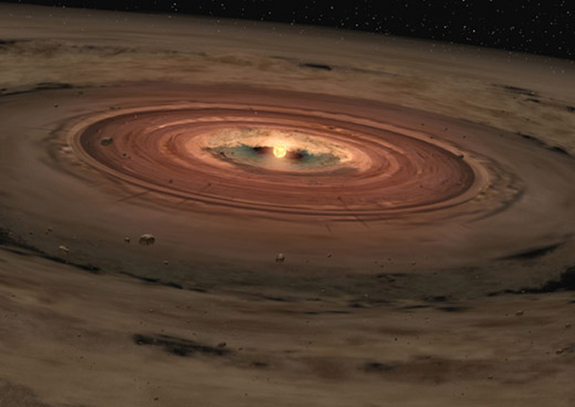
Artist depiction of a similar process.
1. Formation differences
Recent understanding about the formation of our solar system suggests that the source of planetary water is a complicated business that depends on the environment that the central star is born in. That could be bad news for M-Dwarfs, here's why.
The way that water is generally thought to have arrived on Earth is by hitching a ride on space rocks and grains.
Early in our solar system's history, these rocks and grains were spread out in a large disk rotating around the sun. The material in the inner part of the disk was generally too warm to hold water, but rocks and grains beyond the so-called "frost line" at around 2.5 times the Earth-sun distance (which is 93 million miles, or 150 million kilometers) were cold enough to collect ice crystals.
The Earth and the other terrestrial planets presumably formed inside the frost line, so technically they should be dry. However, gravitational interactions in the outer part of the disk apparently stirred up the planetary ingredients, driving ice-carrying material into the inner solar system. The end result: an ocean-filled Earth brimming with life's possibility.
In 2007, two separate research groups modelled the planet-formation recipe which built our solar system and Earth but with half the ingredients. The results were disappointing for water. Planets in the habitable zone around M dwarf stars are dry, according to these models.
One of the reasons for this lack of water is that M dwarfs start out with smaller planetary disks. Researchers found that smaller disks have fewer gravitational interactions and therefore are less efficient at driving ice-carrying material into the inner disk region.
2. Stellar Flux is higher during M-Dwarf's Early Years and Pushes the "Snow Line" Further Out
Another knock against low-mass stars is that they are brighter when they are younger. This pushes the frost line farther out relative to the eventual habitable zone. It becomes even harder to bring in water-bearing material when it starts so far out.
Since the habitable zone of a cooler M-Dwarf is much closer to the star than the one around our Sun....
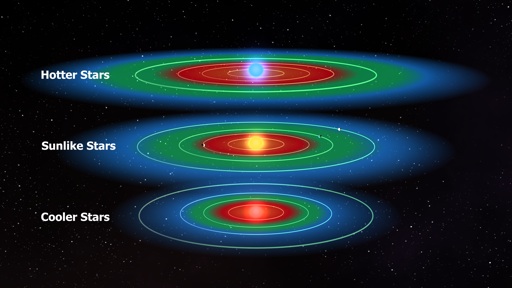
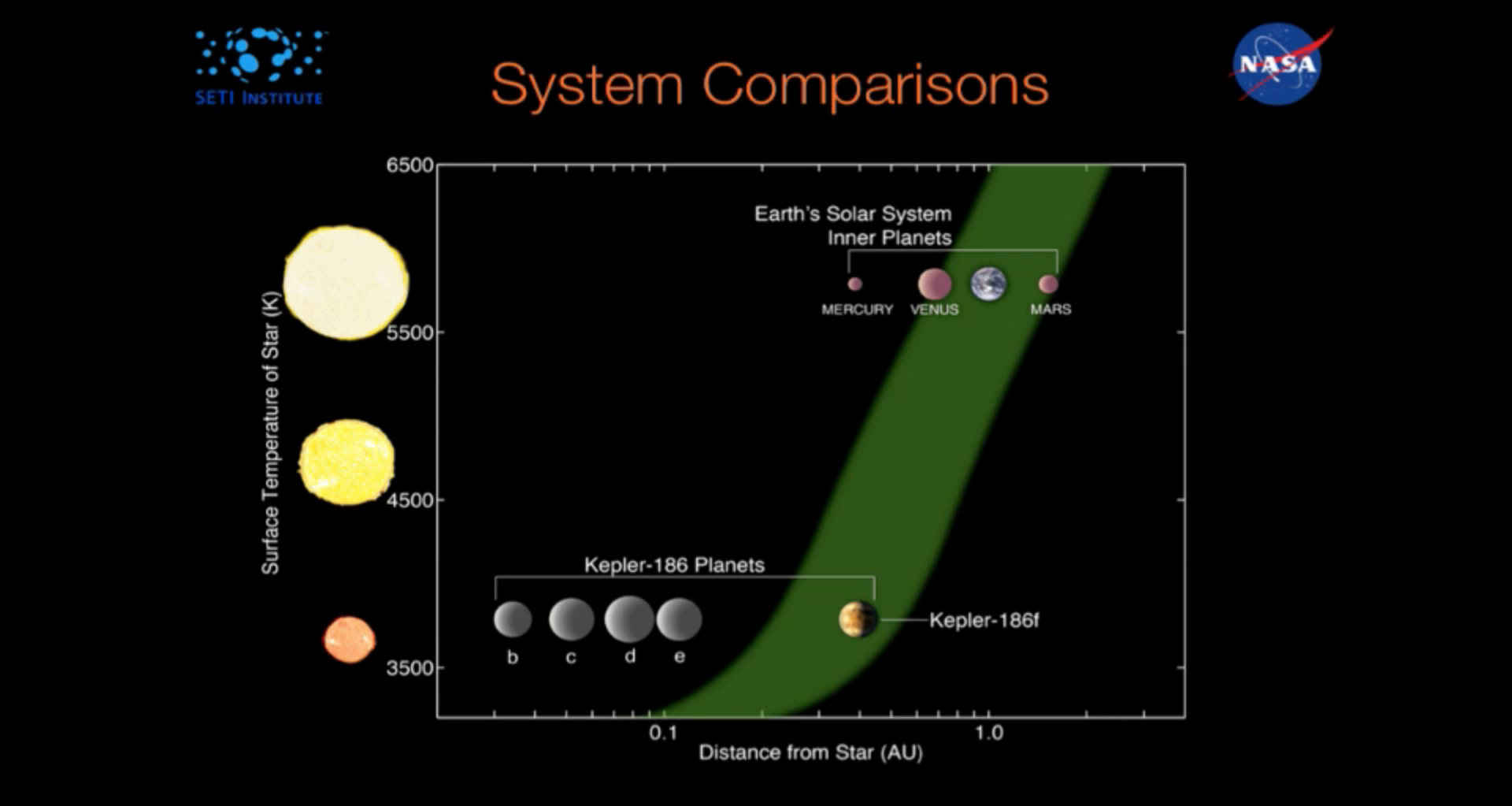
The already dry planet is less likely to receive much in the way of water through the processes which are thought to have brought water to the Earth.
It should be noted that as wet as the Earth is, it is not the wettest world in our solar system by volume:
Here is the volume of all of the water of the Earth in a single sphere. And the smaller sphere is all the fresh water of the Earth courtesy of the USGS:
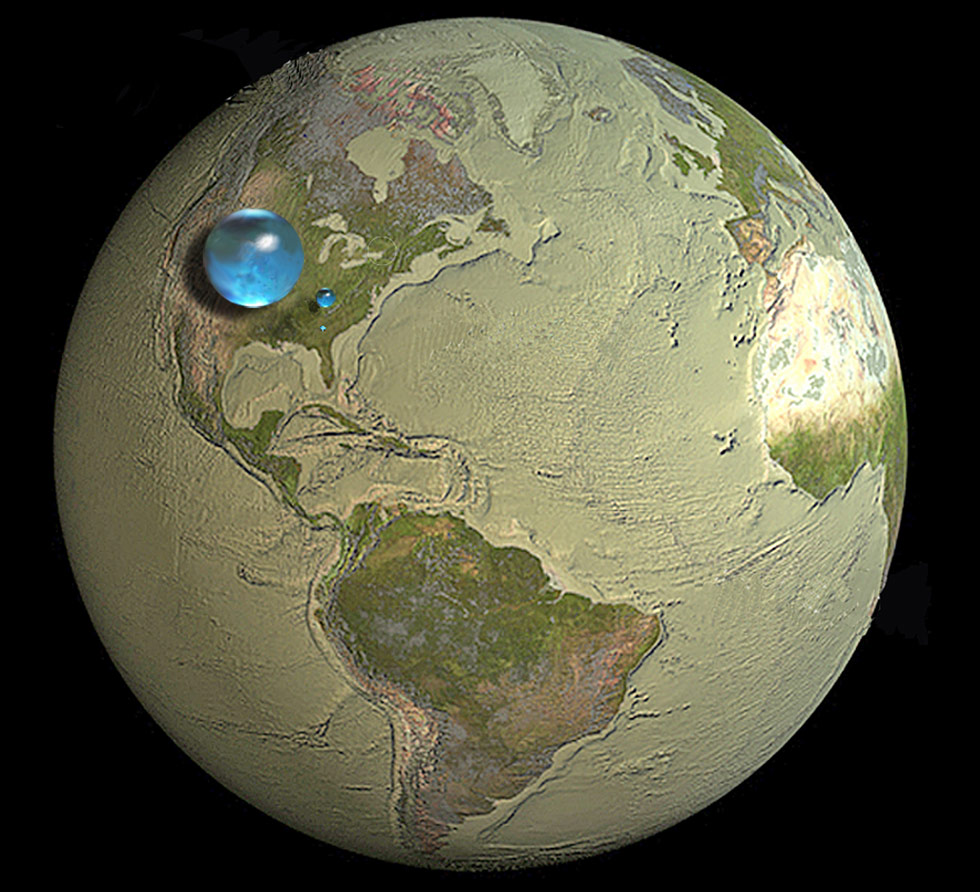
Now let's compare:
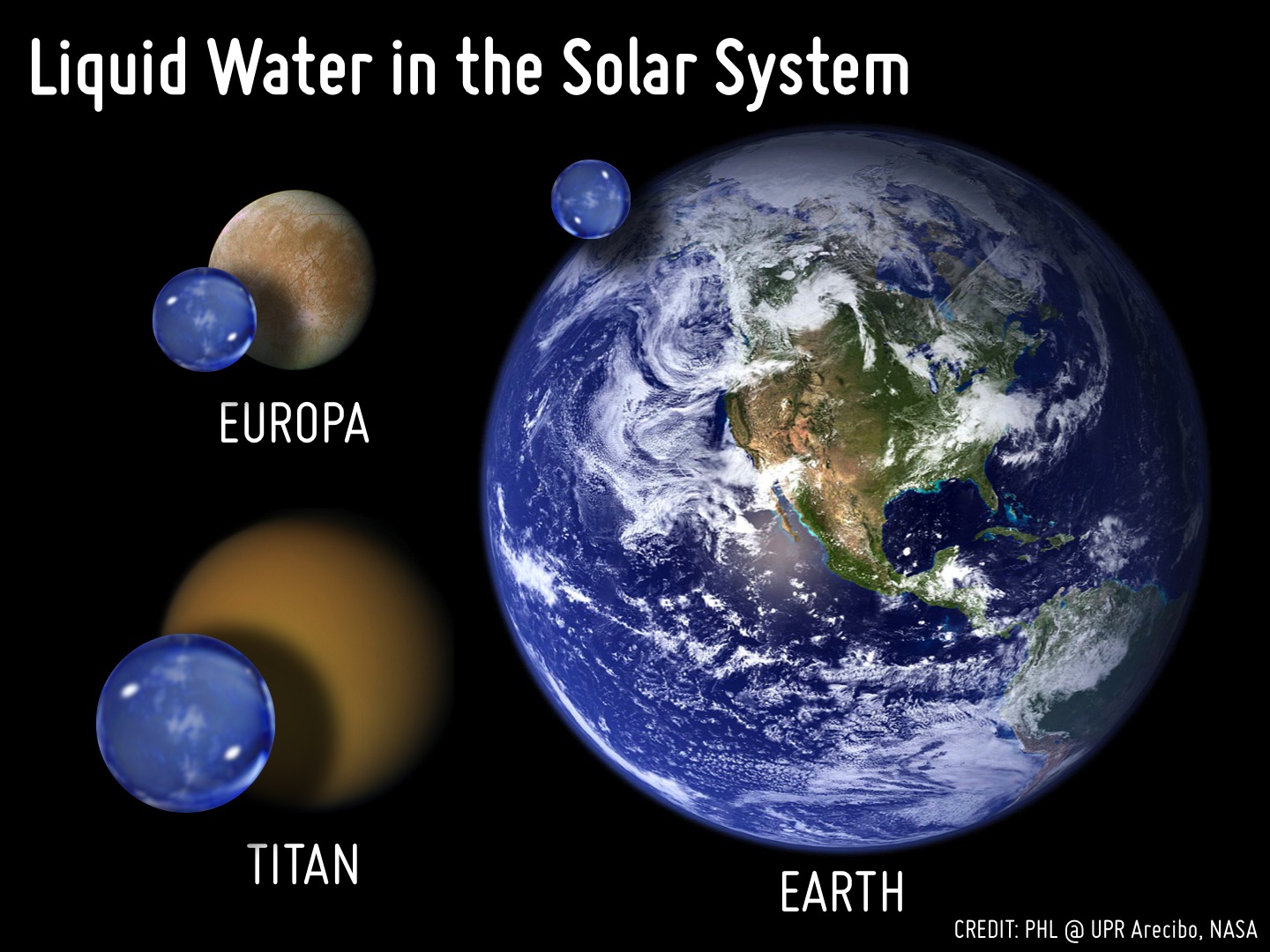
As you can see both Europa, a moon of Jupiter, and Titan a moon of Saturn have more in the way of water. Europa is thought to have a vast ocean larger by volume than all the oceans of Earth below its icy surface. Meanwhile on Titan that water is locked up as ice on the surface but there is some research to suggest that it too may have a vast underground liquid ocean.
The reason Titan and Europa both have more water than the Earth is precisely the same reason that the M-Dwarf planets might be much drier than the Earth, because they are out beyond the snow line and as such were more likely to encounter water ices than the Earth.
3. Baked at Birth
Once planets formed, about 10 million years after the star's formation, they would be subjected to a harsh blast of the star's early activity until it quieted down. Any water present on the planets would be boiled by this intense heat from the star.
SUMMARY:
* M-Dwarfs and their planets form from less material (which is why M-Dwarfs are smaller than our Sun).
* M-Dwarf planets in the Habitable Zone are blasted by the star early in their lifetime both because these stars are more active than our Sun was and because the Habitable Zone of an M-Dwarf is closer so water might be boiled off early.
* And because the material which helped bring water to the early earth will be much further out in the case of an M-Dwarf planet it is less likely to receive much.
Now, ever the optimist I plan to ask one of the people involved in the study referenced in the OP what this might mean in systems where planets have migrated inwards over time.
Could a previously frozen world early in the formation process somehow become habitable over a couple billion years of inward migration?
It was thought that Hot Jupiters formed further out and migrated closer to their star, could the same happen with terrestrial sized M-Dwarf planets so that they start as frozen worlds during the harsh early years of the central star but become warm temperate places over time as they migrate inward?
Those are my questions. Any others for them?
BTW: This is one reason why I think K-Dwarfs, the type of star in between M-Dwarfs and G-dwarf stars like our Sun may be the best places to search for habitable planets and life.
Like M-Dwarfs they are more plentiful than stars like our Sun but they don't have the drawbacks of M-Dwarfs. Planets can orbit in their Habitable Zones without becoming tidally locked. The stars have more in common with ones like our Sun, typically have less scorching flares than M-Dwarfs and will live longer lives than G-Type stars like our Sun giving even more time for interesting biology (technology?) to develop.
It could possibly be that the seldom mentioned K-Dwarfs are the most common places for life in the Universe. Maggie Turnbull agreed with me when I asked her about this possibility at the Kepler Science Conference II.
It should be stressed that planetary habitability is an EXTREMELY complex thing to determine and we're just in the early days of observational astronomy to determine this:

The good news is if we are lucky, we just might be able to examine a nearby M-dwarf planet in the Habitable Zone in detail since the nearest one is likely less than 38 light years away (pretty close in cosmic terms). That would go a long way to determining if this research is correct.
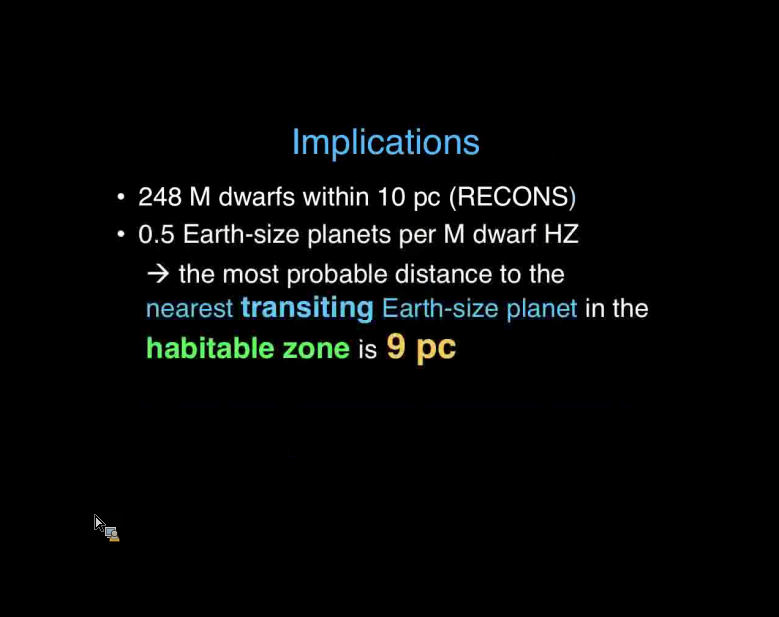
If it oriented properly, NASA's TESS Mission will find it and select it for follow-up with the James Webb Space Telescope.
*crosses fingers*
Ok here's the deal. I hope this is a good answer but based on everything known about planet formation the conventional wisdom is that planets around M-Dwarfs have two or three knocks against them and could be fairly dry places.

Planets forming in the disk around the K-dwarf star HL Tauri (taken by the Atacama Large Millimeter Array aka ALMA)

Artist depiction of a similar process.
1. Formation differences
Recent understanding about the formation of our solar system suggests that the source of planetary water is a complicated business that depends on the environment that the central star is born in. That could be bad news for M-Dwarfs, here's why.
The way that water is generally thought to have arrived on Earth is by hitching a ride on space rocks and grains.
Early in our solar system's history, these rocks and grains were spread out in a large disk rotating around the sun. The material in the inner part of the disk was generally too warm to hold water, but rocks and grains beyond the so-called "frost line" at around 2.5 times the Earth-sun distance (which is 93 million miles, or 150 million kilometers) were cold enough to collect ice crystals.
The Earth and the other terrestrial planets presumably formed inside the frost line, so technically they should be dry. However, gravitational interactions in the outer part of the disk apparently stirred up the planetary ingredients, driving ice-carrying material into the inner solar system. The end result: an ocean-filled Earth brimming with life's possibility.
In 2007, two separate research groups modelled the planet-formation recipe which built our solar system and Earth but with half the ingredients. The results were disappointing for water. Planets in the habitable zone around M dwarf stars are dry, according to these models.
One of the reasons for this lack of water is that M dwarfs start out with smaller planetary disks. Researchers found that smaller disks have fewer gravitational interactions and therefore are less efficient at driving ice-carrying material into the inner disk region.
2. Stellar Flux is higher during M-Dwarf's Early Years and Pushes the "Snow Line" Further Out
Another knock against low-mass stars is that they are brighter when they are younger. This pushes the frost line farther out relative to the eventual habitable zone. It becomes even harder to bring in water-bearing material when it starts so far out.
Since the habitable zone of a cooler M-Dwarf is much closer to the star than the one around our Sun....


The already dry planet is less likely to receive much in the way of water through the processes which are thought to have brought water to the Earth.
It should be noted that as wet as the Earth is, it is not the wettest world in our solar system by volume:
Here is the volume of all of the water of the Earth in a single sphere. And the smaller sphere is all the fresh water of the Earth courtesy of the USGS:

Now let's compare:

As you can see both Europa, a moon of Jupiter, and Titan a moon of Saturn have more in the way of water. Europa is thought to have a vast ocean larger by volume than all the oceans of Earth below its icy surface. Meanwhile on Titan that water is locked up as ice on the surface but there is some research to suggest that it too may have a vast underground liquid ocean.
The reason Titan and Europa both have more water than the Earth is precisely the same reason that the M-Dwarf planets might be much drier than the Earth, because they are out beyond the snow line and as such were more likely to encounter water ices than the Earth.
3. Baked at Birth
Once planets formed, about 10 million years after the star's formation, they would be subjected to a harsh blast of the star's early activity until it quieted down. Any water present on the planets would be boiled by this intense heat from the star.
SUMMARY:
* M-Dwarfs and their planets form from less material (which is why M-Dwarfs are smaller than our Sun).
* M-Dwarf planets in the Habitable Zone are blasted by the star early in their lifetime both because these stars are more active than our Sun was and because the Habitable Zone of an M-Dwarf is closer so water might be boiled off early.
* And because the material which helped bring water to the early earth will be much further out in the case of an M-Dwarf planet it is less likely to receive much.
Now, ever the optimist I plan to ask one of the people involved in the study referenced in the OP what this might mean in systems where planets have migrated inwards over time.
Could a previously frozen world early in the formation process somehow become habitable over a couple billion years of inward migration?
It was thought that Hot Jupiters formed further out and migrated closer to their star, could the same happen with terrestrial sized M-Dwarf planets so that they start as frozen worlds during the harsh early years of the central star but become warm temperate places over time as they migrate inward?
Those are my questions. Any others for them?
BTW: This is one reason why I think K-Dwarfs, the type of star in between M-Dwarfs and G-dwarf stars like our Sun may be the best places to search for habitable planets and life.
Like M-Dwarfs they are more plentiful than stars like our Sun but they don't have the drawbacks of M-Dwarfs. Planets can orbit in their Habitable Zones without becoming tidally locked. The stars have more in common with ones like our Sun, typically have less scorching flares than M-Dwarfs and will live longer lives than G-Type stars like our Sun giving even more time for interesting biology (technology?) to develop.
It could possibly be that the seldom mentioned K-Dwarfs are the most common places for life in the Universe. Maggie Turnbull agreed with me when I asked her about this possibility at the Kepler Science Conference II.
It should be stressed that planetary habitability is an EXTREMELY complex thing to determine and we're just in the early days of observational astronomy to determine this:

The good news is if we are lucky, we just might be able to examine a nearby M-dwarf planet in the Habitable Zone in detail since the nearest one is likely less than 38 light years away (pretty close in cosmic terms). That would go a long way to determining if this research is correct.

If it oriented properly, NASA's TESS Mission will find it and select it for follow-up with the James Webb Space Telescope.
*crosses fingers*
edit on 3-12-2014 by JadeStar because: (no reason given)
when you ask them stuff could you ask about the recent discovery of water at the mantle core boundary that is a bout 400 percent or so of the water we
thought earth had. i mean it may have implications about water retention given the pressure and temperature there. also please ask them what effects
the extreme longevity of red dwarfs would have. some of these things might just be first generation stars. they really can live that long. during that
time a lot of stuff can happen. its like comparing the stuff an infant has seen to the stuff a centurnarian has seen.
i know the arguments they made but something about them just doesn't make sense. i cannot help but think it's over simplified.
i know the arguments they made but something about them just doesn't make sense. i cannot help but think it's over simplified.
ocean in earth's mantle:
www.extremetech.com...
I actually lump the larger ks in with Gs. there is very little difference between either alpha centauri and alpha centauri b. one is a k star. it is slightly smaller than Sol. while the other is a G and slightly larger than Sol. epsilon iridani has a k star. it's a bit more different from sol than the centauri k star but it would still do in a pinch.
the main difference is a slight redder color. both would support even earth evolved life. most of our plants would not care about the slight spectral and brightness differences.
EDIT: we would be luckier if the upcoming study of alpha proxima centauri and b net a planet in their habitability zones
e
dit on 3-12-2014 by stormbringer1701 because: (no reason given)
I actually lump the larger ks in with Gs. there is very little difference between either alpha centauri and alpha centauri b. one is a k star. it is slightly smaller than Sol. while the other is a G and slightly larger than Sol. epsilon iridani has a k star. it's a bit more different from sol than the centauri k star but it would still do in a pinch.
the main difference is a slight redder color. both would support even earth evolved life. most of our plants would not care about the slight spectral and brightness differences.
EDIT: we would be luckier if the upcoming study of alpha proxima centauri and b net a planet in their habitability zones
edit on 3-12-2014
by stormbringer1701 because: (no reason given)
edit on 3-12-2014 by stormbringer1701 because: I meant Sol no earth
originally posted by: eriktheawful
a reply to: JadeStar
Thank you for a good read!
You're posts and threads remind me of the Time-Life books about space I used to pour over as a kid.
Thanks. I loved those books. They and stuff by Carl Sagan, Ian Ridpath were huge influences on my career choice.
If you like those books I HIGHLY recommend this one:
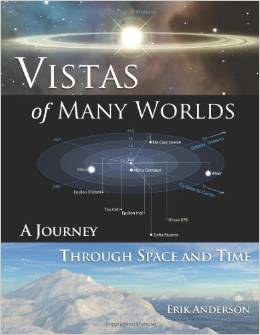
There are 3 new for $10 on Amazon.
I think you will enjoy it. It reads like a sci-fi journey but you learn something about each place and time along it and has beautiful imagery since it was written by an astronomer who also happens to be a visual artist.
originally posted by: stormbringer1701
when you ask them stuff could you ask about the recent discovery of water at the mantle core boundary that is a bout 400 percent or so of the water we thought earth had. i mean it may have implications about water retention given the pressure and temperature there. also please ask them what effects the extreme longevity of red dwarfs would have. some of these things might just be first generation stars. they really can live that long. during that time a lot of stuff can happen. its like comparing the stuff an infant has seen to the stuff a centurnarian has seen.
i know the arguments they made but something about them just doesn't make sense. i cannot help but think it's over simplified.
I will ask this Hopefully I will have an answer by this time next week.
edit on 3-12-2014 by JadeStar because: (no reason given)
new topics
-
12 jurors selected in Trump criminal trial
US Political Madness: 2 hours ago -
Iran launches Retalliation Strike 4.18.24
World War Three: 2 hours ago -
Israeli Missile Strikes in Iran, Explosions in Syria + Iraq
World War Three: 2 hours ago -
George Knapp AMA on DI
Area 51 and other Facilities: 8 hours ago -
Not Aliens but a Nazi Occult Inspired and then Science Rendered Design.
Aliens and UFOs: 8 hours ago -
Louisiana Lawmakers Seek to Limit Public Access to Government Records
Political Issues: 10 hours ago
top topics
-
BREAKING: O’Keefe Media Uncovers who is really running the White House
US Political Madness: 15 hours ago, 25 flags -
George Knapp AMA on DI
Area 51 and other Facilities: 8 hours ago, 23 flags -
Biden--My Uncle Was Eaten By Cannibals
US Political Madness: 16 hours ago, 18 flags -
Israeli Missile Strikes in Iran, Explosions in Syria + Iraq
World War Three: 2 hours ago, 12 flags -
"We're All Hamas" Heard at Columbia University Protests
Social Issues and Civil Unrest: 16 hours ago, 7 flags -
Louisiana Lawmakers Seek to Limit Public Access to Government Records
Political Issues: 10 hours ago, 7 flags -
So I saw about 30 UFOs in formation last night.
Aliens and UFOs: 13 hours ago, 5 flags -
Not Aliens but a Nazi Occult Inspired and then Science Rendered Design.
Aliens and UFOs: 8 hours ago, 4 flags -
Iran launches Retalliation Strike 4.18.24
World War Three: 2 hours ago, 4 flags -
The Tories may be wiped out after the Election - Serves them Right
Regional Politics: 12 hours ago, 3 flags
active topics
-
Running Through Idiot Protestors Who Block The Road
Rant • 109 • : Astyanax -
Iran launches Retalliation Strike 4.18.24
World War Three • 10 • : VoiceofReality -
12 jurors selected in Trump criminal trial
US Political Madness • 20 • : Lumenari -
MULTIPLE SKYMASTER MESSAGES GOING OUT
World War Three • 43 • : SchrodingersRat -
Pfizer is 'deeply sorry'
Diseases and Pandemics • 23 • : VoiceofReality -
Israeli Missile Strikes in Iran, Explosions in Syria + Iraq
World War Three • 47 • : YourFaceAgain -
It has begun... Iran begins attack on Israel, launches tons of drones towards the country
World War Three • 887 • : 5thHead -
The Tories may be wiped out after the Election - Serves them Right
Regional Politics • 20 • : ScarletDarkness -
Terrifying Encounters With The Black Eyed Kids
Paranormal Studies • 44 • : Consvoli -
George Knapp AMA on DI
Area 51 and other Facilities • 20 • : theshadowknows
